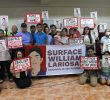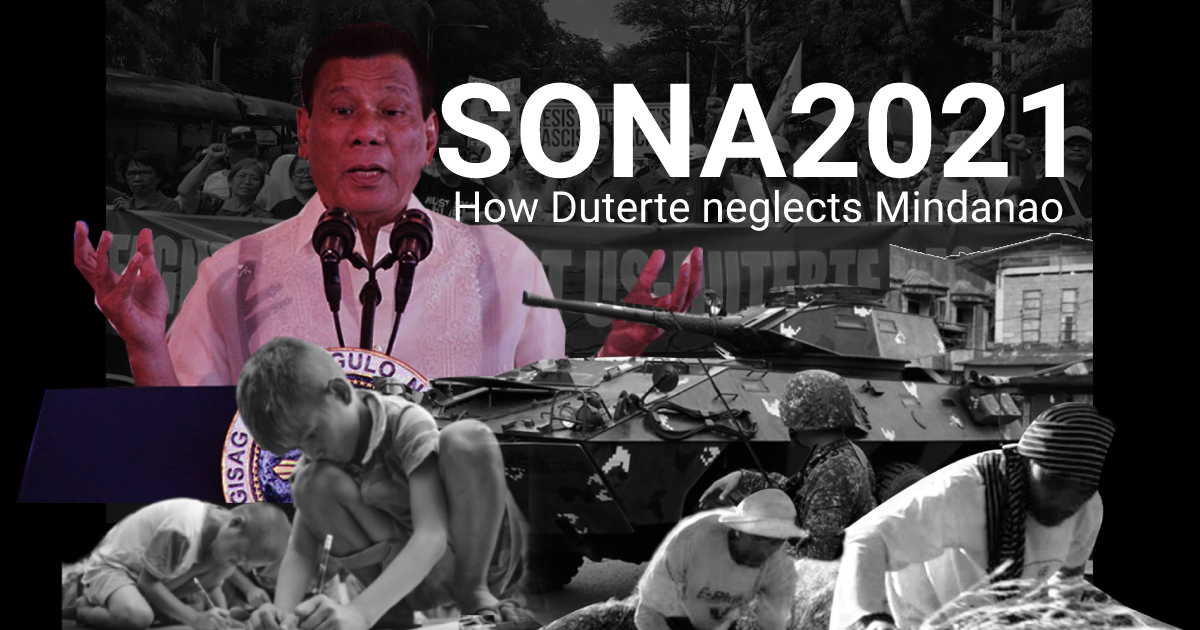
DAVAO CITY, PHILIPPINES – President Rodrigo Duterte will deliver his fifth and last State of the Nation Address (SONA) on July 26.
After five years in the presidency, this SONA will probably address the legacy of the Duterte presidency.
Duterte rode to the presidency on a sentiment of championing Mindanao, where his hometown Davao City is located, an island that saw what he calls “historical injustice” of underdevelopment and armed conflict.
But did the Duterte administration bring the promise to champion Mindanao? Let us look back at the major issues of the Duterte administration that have affected the Mindanao people.
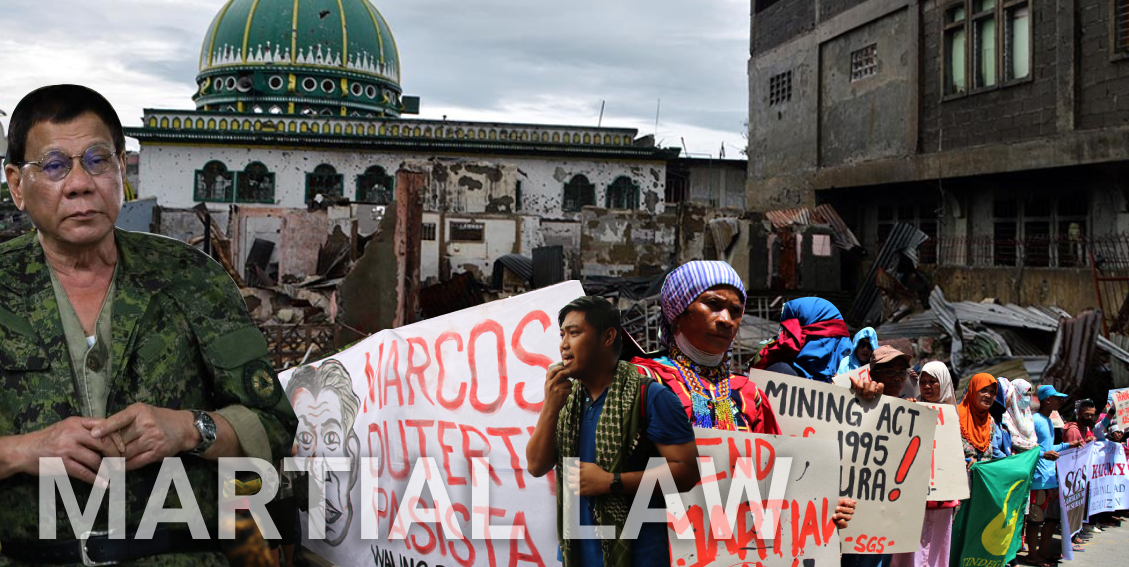
Martial Law leaves Marawi in ruins
On May 23, 2017, when news broke out that the ISIS-inspired Maute group and Abu Sayyaf members were spotted in Marawi City, Duterte’s immediate response was to place the entire island of Mindanao under Martial Law via Proclamation Number 216.
The Constitution grants the president to declare Martial law in times of an invasion or rebellion where public safety is at risk. The declaration should last 60 days. The president is also mandated to submit a report within two days to Congress, which can either approve or suspend the declaration. The President can also initiate a call to Congress to extend Martial Law.
While the president declared Marawi “liberated” with the deaths of the rebel leaders on October 17, 2017, Congress extended Martial Law three times until the year-end of 2019.
Marawi’s “liberation” and Martial Law extension did not speed up the rebuilding of the city, or the return of 300,000 residents to the city.
The residents also dwelled with pain and fear over the loss of home and livelihood, as Davao Today reported here and here.
Over the past years, the Meranaos grew impatient with the rehabilitation work led by Task Force Bangon Marawi.
On the fourth anniversary of the Siege this year, a Meranaw coalition said the people “up to this day, enduring the profound and unceasing pains” of the five-month siege that claimed over 1,200 lives and displaced more than 300,000 in 2017.”
Martial Law abuses
The 952 days under Martial Law found the military establishing 17,494 checkpoints in the eastern part of Mindanao, implemented curfews in 129 cities and municipalities and deployed 9,742 personnel.
Such a wide scope of this so-called security made Karapatan say this gave “full blanket authority to commit rights abuses.”
Karapatan reported that during Martial Law in Mindanao they recorded over 800,000 individual cases of violations, including 93 cases of extrajudicial killings, 1,450 illegal arrests, six enforced disappearances, 35 incidents of torture, 423,000 victims of “forcible evacuations,” and around 28,000 were cases of threats, harassment, and intimidation
The group said that in Davao Region, there are reported 66 political killings during the period of Martial Law, while 133 activists and rights defenders in communities were arrested with trumped-up charges.
They highlighted the cases of the murder by the paramilitary of a student of a Lumad school in Talaingod in 2018, and the murders of Datu Victor Danyan and seven Dulangan Manobo in Datal Bonglanon, South Cotabato on December 2017. The 27th Infantry Battalion claimed they killed New People’s Army rebels, but the community said Danyan was attacked for standing his ground against a coffee plantation encroaching on their ancestral land.
Rights activists in various regions in Mindanao have held protests through the years to highlight the abuses experienced by Lumad, Moro, farmers and workers under Martial Law.
Duterte has deployed 74 battalions of the Armed Forces of the Philippines in Mindanao most of them in Davao Region and Bangsamoro Autonomous Region in Muslim Mindanao (BARMM). More than 20 paramilitary armed groups under the control, supervision, and direction of the AFP are operating in rural communities.
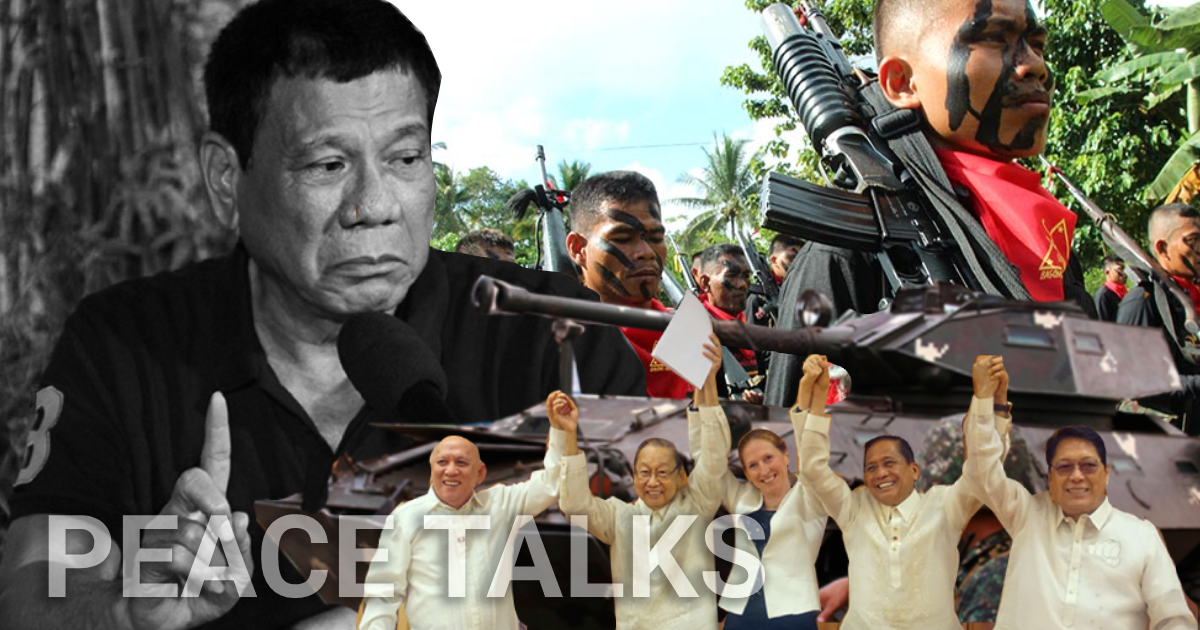
360 in the Peace Talks
Duterte raised hopes of addressing the roots of the communist urgency when he resumed peace talks with the National Democratic Front of the Philippines (NDFP) which was suspended by the previous administration in 2011.
With his good relations as mayor with the NDFP and its armed wing the New People’s Army, Duterte released NDFP consultants and welcomed them to an unprecedented meeting in Malacanang. In one year, both NDFP and government peace panels met four times to discuss socio-economic reforms.
Duterte changed tact during the Marawi crisis when he declared that the NPA would be the next war after the Marawi crisis. He did not pursue the fifth round of talks on May 2017.
Duterte claimed he can no longer accommodate demands of the NDF for “a coalition government.” But the NDFP also said the government issued “unreasonable demands” in the fifth and last round of the talks before it was canceled in 2017. The demands included a joint ceasefire without the “necessary agreements” on social, economic and political reforms.
The president issued Proclamation 360 terminating the talks. He also suspended the Joint Agreement on Security and Immunity (JASIG), and this led to the arrest and attacks on peace consultants who were temporarily released from detention to participate in the peace talks.
November last year, police arrested a former NDFP peace process consultant, Wilfredo “Ka Paris” Mapano, who was working for the state-owned Phividec Industrial Authority in Tagoloan, Misamis Oriental.
Another peace consultant from Mindanao was also arrested in a raid in Quezon City and charged with illegal possession of firearms.
NDFP Mindanao spokesperson Alvin Luque, alias Ka Joaquin Jacinto, was murdered during a military raid on Human Rights Day last year in a resort in Tandag where he was hiding while recovering from partial paralysis.
And in Duterte’s latest move to crush the communist-led rebellion has been designation of the NDFP as a terror organization by the Anti-Terrorism Council (ATC) just a week before his SONA. Duterte together with the military has vowed to end the world’s longest running rebellion in 2022.

Attacks on Lumad schools
Along with the president’s declaration of war against communist rebels, Duterte has put Lumad communities and schools in the line of fire. His pronouncement after SONA 2017 to bomb Lumad schools in Mindanao was in essence the red-tagging of the Lumad.
Military operations in lumad schools resulted in the closure of 178 alternative Lumad schools all over Mindanao that were operated by religious groups or NGOs, displacing 5,500 students, the Save Our Schools Network reports.
In 2019, the Department of Education (DepEd) Davao region ordered the closure of 54 Salugpungan Ta’Tanu Igkanogon Community Learning Center, Inc. (STTICLCI), mostly based in Talaingod. The issuance was based on the recommendation of National Security Adviser Hermogenes Esperon Jr. who accused the school of not following the DepEd curriculum and teaching “ideologies that advocate against the government.”
These cases led SOS to form the Lumad Bakwit Schools as refuge of students in universities in Metro Manila and Cebu City to continue their studies amid the heightened militarization on Mindanao.
But even Bakwit Schools were also attacked as what happened on February 2021 when 26 people including lumad students, teachers, and elders were forcibly taken away by police and personnel of the Department of Social Welfare and Development (DSWD) in a “rescue” operation the University of San Carlos-Talamban Campus (USC). Lumad families fought over custody of 19 minors taken by the City Social Welfare and Development (CSWD) office while teachers and Lumad leaders were charged with kidnapping. The court dismissed the cases against them and they decried harassment and bribery during their detention.
Lumad further marginalized
The attacks on schools and the Lumad intensified with the National Task Force to End Local Communist Armed Conflict (NTF-ELCAC) engaging in red-tagging and implementing forced surrender schemes in rural communities.
Mass evacuations were reported in the regions of SOCKSARGEN, Caraga, Southern Mindanao and Northern Mindanao due to massive military operations after the Marawi crisis. In July 2018, some 328 families or 1,607 individuals from 15 villages in the municipalities of San Agustin, Tago, and Lianga, Surigao del Sur fled their homes after the military encamped in their communities for a month.
In 2019, Karapatan Southern Mindanao reported an initial count of 512 Lumad people malicious tagged as NPA fighters or supporters.
Attacks also persist in sanctuaries for lumad evacuees such as the case in UCCP Haran in Davao City where the paramilitary Alamara barged in on January 2020, which happened 10 days after the Davao Regional Peace and Order Council XI issued the closure of UCCP Haran.
Lumad leaders were also attacked. Talaingod leader Datu Kaylo Bontulan was killed during a military air bombing in Kitaotao, Bukidnon on April 7, 2019 at a Lumad community which he stayed on to check on Talaingod evacuees who fled to that community. Bontulan was tagged by the military as an NPA combat fighter.
Higaonon leader Datu Jomorito Goaynon, chairperson of the Kalumbay Lumad Organization in Northern Mindanao, was arrested with a peasant leader in Cagayan de Oro on January 28, 2019. The military claimed he carried firearms and explosives while aboard a jeep. Goaynon was also charged for violation of the Human Security Act, the law that is now replaced by the Anti-Terrorism Act (ATA).
The charges were dismissed but he still remains in detention facing more charges which his lawyers said are fabricated to silence Goaynon and other Lumad who stood up against mining and plantation expansion into ancestral domain. Goaynon is among the petitioners to the Supreme Court to junk the Anti Terrorism Act.
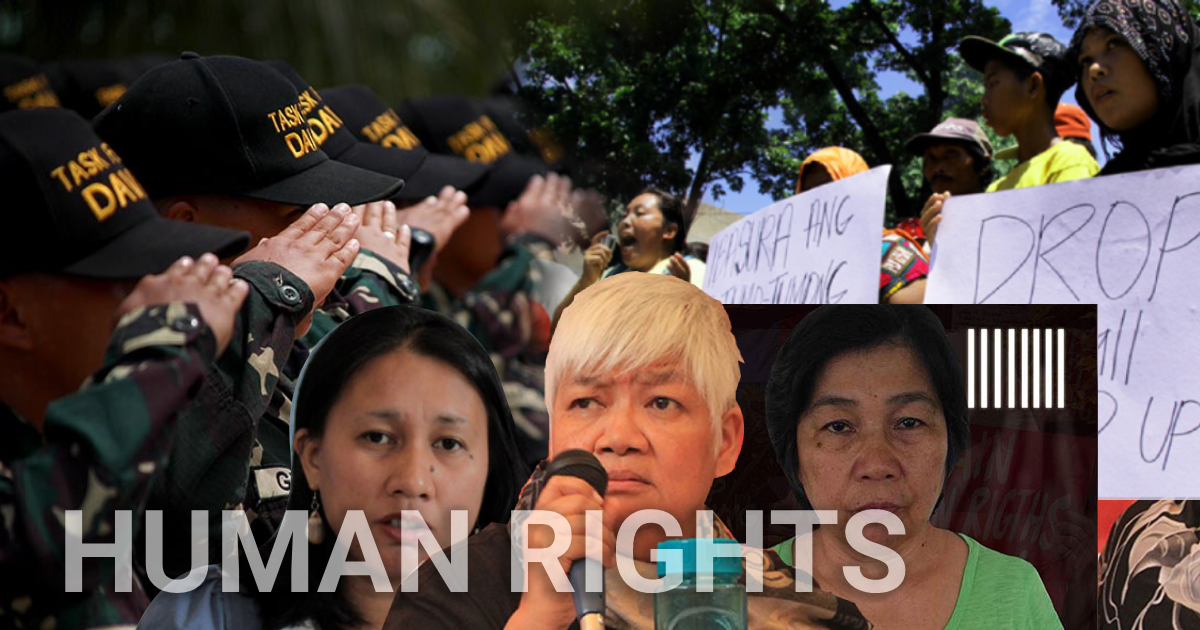
Rights defenders, journalists under siege
Duterte was once an ally of activists during his term as mayor and raised human rights concerns as chair of Davao Region’s peace and order council.
But as president, his administration has zeroed in on human rights defenders by red-tagging, arrests, trumped-up charges and even enforced disappearance.
Karapatan reported that the Provincial Prosecutors Office of Bayugan City filed charges of kidnapping, arson, robbery and serious illegal detention against 468 individuals, including 78 known activists in Caraga and Northern Mindanao.
This has led to arrest of activist leaders in Caraga representing unions, Lumad and women groups .
Karapatan members in Mindanao were also arrested including paralegal Engineer Jennefer Aguhob in Oroquieta City, and its council member Teresita Naul in Misamis Oriental, who was tagged by the 4th Infantry Division (4ID) as a “top-ranking terrorist” and was detained in Bayugan, Agusan del Sur and later transferred in Lumbia City Jail in Cagayan de Oro City.
Former Karapatan Southern Mindanao Secretary General Hanimay Suazo was abducted on November 2, 2019, and remains missing to date.
In their report, Karapatan documented from July 2016 to December 2020 a total of 173 cases of extrajudicial killings in Mindanao, with most cases happening in Southern Mindanao Region. In addition, there are 12 cases of enforced disappearances including the case of Suazo.
Even veteran journalist and Davao Today columnist Margarita Valle became a victim of illegal arrest and trumped-up charges in 2019, when she was taken by a joint operative of the Criminal Investigation and Detection Group (CIDG), 102nd Brigade and 53rd Infantry Battalion at the Laguindingan Airport in Misamis Oriental, based on arrest warrants of an NPA leader “Elsa Renton” and charged with “multiple murder with quadruple frustrated murder,” destruction of government property and arson. She was released after authorities claimed this was a case of “mistaken identity.”
The case of Valle also highlighted other attacks on journalists in Mindanao who exercised their role as watchdog of the government, only to be subject to red-tagging, surveillance and harassment.

Workers’ struggles
Union repression worsened in the past years despite the president’s promise to end labor-only contracting or ‘endo’ under his administration.
The Duterte administration employed more contract workers than before, from 595,000 “contract of service” employees in the public sector in 2016, the number increased to 660,390 in 2017.
Contractualization which lasts from five to six months results in lack of job security and failure to provide allowances and work benefits to workers.
This has resulted in strikes from workers in NutriAsia, Coca Cola and Philippine Long Distance Telephone (PLDT) as these companies defied orders from the Department of Labor (DOLE) to regularize its employees and instead laid off workers.
Strikes in various industries exceeded the number recorded from 2008 to 2015 in just three years of the Duterte administration based on 2018 data from the Department of Labor and Employment and National Conciliation and Mediation Board.
In Davao Region, the fight against ‘endo’ united three labor groups during a Labor Day protest in 2018.
Workers in Davao Region continue to confront harassment amid their struggles.
In April 2018, members of Kilusang Manggagawa ng Coca-Cola (KIMACO KMU) staged a picket at the company gates to call for the reinstatement of 72 workers who were dismissed in March 2018 and the regularization of all contractual workers under Coca-Cola FEMSA Davao. The protest was violently dispersed where 10 union members were arrested and charged for resisting arrest and grave coercion. Their case was dismissed in December 2018.
In 2017, some 1,000 banana plantation workers of the Japanese-owned Sumitomo Fruits (Sumifru), under the union Nagkahiusang Mamumuo sa Suyapa Farm (NAMASUFA-NAFLU-KMU), started their barricade in seven packing plants to demand for a collective bargaining and to protect them from reported unfair labor practices.
The strike lasted for two long years of struggle as they became targets of red-tagging and “forced surrender” schemes by the military. One of their union members Danny Bautista was shot dead while union leader Victor Ageas survived an ambush by motorcycle-riding gunmen.
Some 600 workers won their labor disputes on their dismissal for joining the strike barricade, but the company has refused to reinstate them. Their struggle continues.
Last SONA
These issues may not be mentioned in Duterte’s last SONA, or if they may be mentioned it might be under the breath of threatening the sectors in Mindanao whom the president once said he would protect.
It is now a challenge for the next president after the 2022 elections to take on these issues, to again “correct historical injustices on Mindanao.”
With a report from Kath M. Cortez
SONA2021



